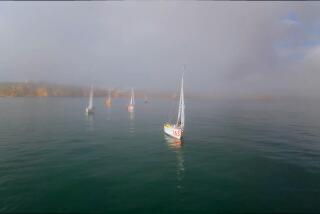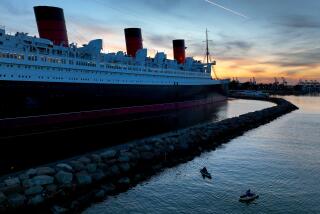Tall Ship’s Restoration Sets Sail on Love
- Share via
PHILADELPHIA — Surrounded by plentiful ash and cedar trees in the 1700s, Philadelphia was a shipbuilding center to rival New England, but got an assist from the Pacific Coast with its latest tall ship repair.
A new lower mizzen mast for the three-masted Gazela arrived on Pier 40 as part of a refurbishing job that will return the ship’s 105-foot-tall silhouette to Philadelphia’s waterfront by November.
Members of the Philadelphia Ship Preservation Guild -- the nonprofit group of about 150 members who repair, caulk, scrape, paint, scrub and sail the Gazela -- watched a crane unload the log, an 80-foot Douglas fir, from a railroad flatcar.
Weyerhaeuser, a timber company, donated the 8,000-pound log, chalk-marked “GAZELA SPAR” on the end; CSX Corp. shipped it cross-country for free; and the services of the crane were donated in the kind of promotional coordinating feat the group must pull off regularly to operate a more-than-a-century-old wooden ship long past its moneymaking days.
“I was there for the arrival of the big stick,” said Bobby Flemming, one of the volunteers who donate hard labor to keep the ship afloat and maintained. The volunteers count every hour because the payoff is a chance of adventure aboard the 177-foot-long former Portuguese fishing vessel as it plies East Coast ports and makes sea voyages to Newfoundland and Bermuda.
“She can be out for months on end,” said Scott Cointot, 32, who has been sailing on Gazela since 1985 and has been one of its captains for the last six years.
A tugboat operator in his paying job, Cointot looked forward to resuming sailing trips on the Gazela after two years of refurbishing.
While the Douglas fir is crafted into a lower section for a mast damaged by rot and carpenter ants, new deck beams and planking are being fashioned by paid shipwrights. Volunteers work in a barge alongside, where the ship’s bell and its varnished, spoked, wheel hang from the ceiling ready to install.
Kvaerner Philadelphia Shipyard also decided to help, sandblasting and applying three coats of tough white paint to the steel cabin that sits on deck and houses the galley with its huge iron oil-burning stove. Kvaerner also supplied three new water tanks and a holding tank installed during the project.
The group hoped to finish in time to sail the ship up the Delaware River for a festival in Bristol on Oct. 19, but a November completion appears more likely, Cointot said.
The festival appearance is quite a contrast to 70 years of grueling sails -- until 1969 -- from Portugal to the Grand Banks fishing grounds off Canada, when it would return loaded to the gills with fish.
Now the ship that hauled 350 tons of codfish sets sail for events like the Operation Sail parade of tall ships in New York Harbor that celebrated the nation’s bicentennial.
“She’s been on all the Op-Sails, 1976, 1986, 1992 and 2000,” Cointot said.
In 1994, the ship was used for the filming of “Interview With a Vampire” in New Orleans. And in spring 1999, Cointot sailed the Gazela to Louisbourg, Nova Scotia, where it was used in making a French film, “La Veuve de St. Pierre.”
The Gazela was chosen after the director declared the ship “perfect” but made sure of two things -- that it could be towed by men rowing in dories and that a horse could be lifted aboard for essential scenes.
The movie was another fund-raising coup, bringing in $40,000 that paid for a new propeller shaft and propeller, and fixed a vibration problem that had slowed the ship when traveling under engine power.
In addition to repairs and maintenance in port, there’s plenty of work for volunteers on trips. Whenever the ship isn’t under way, Cointot said, “I have half the crew washing down the ship and half doing rowing practice.”
“I’ve stood watch on her with sleet in my face,” said Flemming, 69. She began volunteering on weekends or evenings after her job at a bank, put in more time after she retired and earned her first trip, from Miami along the Atlantic Coast to New England, in 2000. Volunteers range from their teens to 80.
“We invite people to come and try us before they join us. It’s not just a nice clean group where you can go to meetings and express ideas,” she said.
“When the masts were taken out in December 2000, we were all down here at 6 a.m. shoveling snow off the deck.”
Ed Stemmler, a University of Pennsylvania information-technology team leader who coordinated the mast’s donation and transportation, said the Gazela owes it to “sheer generosity.”
“I don’t know what I said,” Stemmler said. “There’s just the sense of adventure in a person to think that they are helping a 100-year-old sailing ship in an age when everything else is steel and powered by fuel.”
More to Read
Sign up for The Wild
We’ll help you find the best places to hike, bike and run, as well as the perfect silent spots for meditation and yoga.
You may occasionally receive promotional content from the Los Angeles Times.






